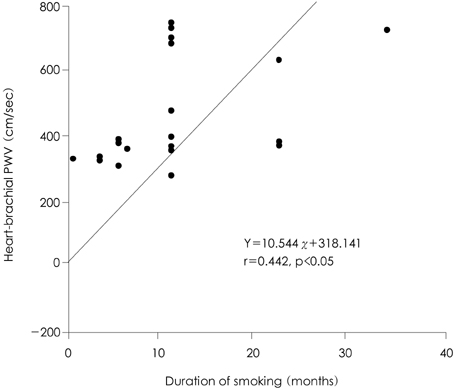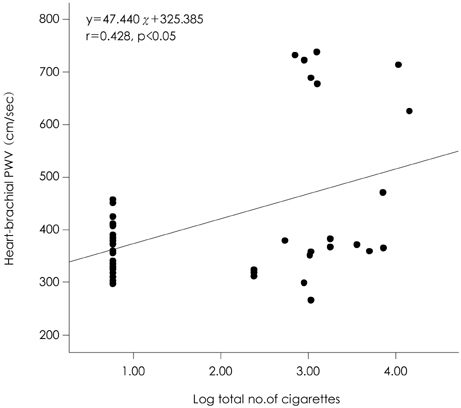Korean Circ J.
2007 Sep;37(9):414-418. 10.4070/kcj.2007.37.9.414.
Effects of Smoking on the Pulse Wave Velocity and Ankle Brachial Index in Adolescents
- Affiliations
-
- 1Department of Pediatrics, School of Medicine, Ewha Womans University, Seoul, Korea. hongym@chollian.net
- 2School Health Promotion Center, Seoul, Korea.
- KMID: 2093977
- DOI: http://doi.org/10.4070/kcj.2007.37.9.414
Abstract
-
BACKGROUND AND OBJECTIVES: Smoking is known to increase arterial stiffness in adults. The pulse wave velocity (PWV) is known as an established index of arterial stiffness. The effects of smoking on the PWV in adolescents have not yet been established. We measured the PWV and ankle-brachial index (ABI) in adolescents to determine the effects of smoking on adolescents.
SUBJECTS AND METHODS
Four hundred twenty-seven adolescents between 14 to 16 years of age were enrolled from three high schools in Seoul, Korea. The study group was comprised of 48 smokers (38 males and 10 females) and 379 nonsmokers (254 males and 125 females). Measurements of the height, weight and body mass index (BMI) were performed. The blood pressures of the extremities, and the PWV, the ABI, the ejection time and the pre-ejection period were measured using an automatic device (VP-1000). Among the smoking group, we investigated the association between the duration of smoking, the age at which smoking started and the total number of cigarettes smoked with the PWV and ABI.
RESULTS
The brachial-ankle PWV (baPWV) in the smoking group was higher than that of the non-smoking group, but the difference was not statistically significant. There was no significant difference between the ABI of the two groups. Among the smokers, the heart-brachial PWV (hbPWV) was significantly associated with the duration of smoking and the total number of cigarettes smoked.
CONCLUSION
Our study showed no significant difference in the PWV between the two groups. A longitudinal, long-term investigation is needed to more accurately determine the effects of smoking on adolescents.
Keyword
MeSH Terms
Figure
Reference
-
1. Stefanadis C, Tsiamis E, Vlachopoulos C, et al. Unfavorable effect of smoking on the elastic properties of the human aorta. Circulation. 1997. 95:31–38.2. Kannel WB, Higgins M. Smoking and hypertension as predictors of cardiovascular risk in population studies. J Hypertens Suppl. 1990. 8:S3–S8.3. Peto R, Lopez AD, Boreham J, Thun M, Heath C Jr. Mortality from tobacco in developed countries: indirect estimation from national vital statistics. Lancet. 1992. 339:1268–1278.4. Kool MJ, Hoeks AP, Struijker Boudier HA, Reneman RS, van Bortel LM. Short- and long-term effects of smoking on arterial wall properties in habitual smokers. J Am Coll Cardiol. 1993. 22:1881–1886.5. Rhee MY. Acute and chronic effects of smoking on the arterial wall properties and the hemodynamics in smokers with hypertension. Korean Circ J. 2005. 35:493–499.6. Mahmud A, Feely J. Effect of smoking on arterial stiffness and pulse pressure amplification. Hypertension. 2003. 41:183–187.7. Failla M, Grappiolo A, Carugo S, Calchera I, Giannattasio C, Mancia G. Effects of cigarette smoking on carotid and radial artery distensibility. J Hypertens. 1997. 15:1659–1664.8. Sassalos K, Vlachopoulos C, Alexopoulos N, Gialernios T, Aznaouridis K, Stefanadis C. The acute and chronic effect of cigarette smoking on the elastic properties of the ascending aorta in healthy male subjects. Hellenic J Cardiol. 2006. 47:263–268.9. Vogt MT, McKenna M, Wolfson SK, Kuller LH. The relationship between ankle brachial index, other atherosclerotic disease, diabetes, smoking and mortality in older men and women. Atherosclerosis. 1993. 101:191–202.10. Chuang SY, Chen CH, Cheung CM, Chou P. Combined use of brachial-ankle pulse wave velocity and ankle-brachial index for fast assessment of arteriosclerosis and atherosclerosis in a community. Int J Cardiol. 2005. 98:99–105.11. Blacher J, Asmar R, Djane S, London GM, Safar ME. Aortic pulse wave velocity as a marker of cardiovascular risk in hypertensive patients. Hypertension. 1999. 33:1111–1117.12. Lee YS, Kim KS, Nam CW, et al. Clinical implication of carotid-radial pulse wave velocity for patients with coronary artery disease. Korean Circ J. 2006. 36:565–572.13. Shiotani A, Motoyama M, Matsuda T, Miyanishi T. Brachial-ankle pulse wave velocity in Japanese university students. Intern Med. 2005. 44:696–701.14. Levenson J, Simon AC, Cambien FA, Beretti C. Cigarette smoking and hypertension. Arteriosclerosis. 1987. 7:572–577.15. Kim JW, Park CJ, Hong SJ, et al. Acute and chronic effects of cigarette smoking on arterial stiffness. Blood Press. 2005. 14:80–85.16. Jatoi NA, Jerrard-Dunne P, Feely J, Mahmud A. Impact of smoking and smoking cessation on arterial stiffness and aortic wave reflection in hypertension. Hypertension. 2007. 49:981–985.17. Vlachopoulos C, Alexopoulos N, Panagiotakos D, O'Rourke MF, Stefanadis C. Cigar Smoking has an acute detrimental effect on arterial stiffness. Am J Hypertens. 2004. 17:299–303.18. Papamichael CM, Lekakis JP, Stamatelopoulos KS, et al. Ankle-brachial index as a predictor of the extent of coronary atherosclerosis and cardiovascular events in patients with coronary artery disease. Am J Cardiol. 2000. 86:615–618.19. Sugawara J, Hayashi K, Yokoi T, et al. Brachial-ankle pulse wave velocity: an index of central arterial stiffness? J Hum Hypertens. 2005. 19:401–406.20. Kubo T, Miyata M, Minagoe S, Setoyama S, Maruyama I, Tei C. A simple oscillometric technique for determining new indices of arterial distensibility. Hypertens Res. 2002. 25:351–358.21. Rehill N, Beck C, Yeo KR, Yeo WW. The effect of chronic tobacco smoking on arterial stiffness. Br J Clin Pharmacol. 2006. 61:767–773.22. Li S, Chen W, Srinivasan SR, Berenson GS. Childhood blood pressure as a predictor of arterial stiffness in young adults: the bogalusa heart study. Hypertension. 2004. 43:541–546.23. Ohmori K, Emura S, Takashima T. Risk factors of atherosclerosis and aortic pulse wave velocity. Angiology. 2000. 51:53–60.24. Benetos A, Adamopoulos C, Bureau JM, et al. Determinants of accelerated progression of arterial stiffness in normotensive subjects and in treated hypertensive subjects over a 6-year period. Circulation. 2002. 105:1202–1207.25. Cruickshank K, Riste L, Anderson SG, Wright JS, Dunn G, Gosling RG. Aortic pulse-wave velocity and its relationship to mortality in diabetes and glucose intolerance: an integrated index of vascular function? Circulation. 2002. 106:2085–2090.26. Farrar DJ, Bond MG, Riley WA, Sawyer JK. Anatomic correlated of aortic pulse wave velocity and carotid artery elasticity during atherosclerosis progression and regression in monkeys. Circulation. 1991. 83:1754–1763.27. Guerin AP, Blacher J, Pannier B, Marchais SJ, Safar ME, London GM. Impact of aortic stiffness attenuation on survival of patients in end-stage renal failure. Circulation. 2001. 103:987–992.28. Lee YS, Kim KS, Hyun DW, et al. The change of arterial stiffness according to dialysis in patients with end-stage renal disease. Korean Circ J. 2004. 34:865–873.29. Wildman RP, Mackey RH, Bostom A, Thompson T, Sutton-Tyrrell K. Measures of obesity are associated with vascular stiffness in young and older adults. Hypertension. 2003. 42:468–473.
- Full Text Links
- Actions
-
Cited
- CITED
-
- Close
- Share
- Similar articles
-
- Pulse wave velocity and ankle brachial index in normal adolescents
- Pulse wave velocity and ankle brachial index in adolescents with essential hypertension
- Usefulness of Brachial-Ankle Pulse Wave Velocity and Ankle-Brachial Index as Predictors of Early Age-Related Maculopathy
- Pulse wave velocity and ankle brachial index in obese adolescents
- Correlation of Arterial Stiffness and Bone Mineral Density by Measuring Brachial-Ankle Pulse Wave Velocity in Healthy Korean Women



